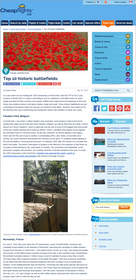TORONTO, ON--(Marketwired - May 21, 2014) - This year, 2014, is an important year for veterans from Canada and around the world as we mark not only the 100th anniversary of World War I but also the 70th for the D-Day invasion of World War II coming up on June 6th. To honour these solemn anniversaries and war heroes throughout history, the travel experts at Cheapflights.ca, the online leader in finding and publishing travel deals, have compiled a list of Top 10 Historic Battlefields highlighting places that preserve the past to keep alive the memory of those who fought for their countries.
Below we salute three battlefields -- each of which is observing a milestone anniversary this year -- that hold a special place in the heart of Canadians:
- Flanders Field, Belgium - In World War I, more than 1 million soldiers were wounded, went missing or died in the trench warfare that raged across East and West Flanders, Belgium, as well as Nord-Pas-de-Calais, France (known as French Flanders). Ypres in particular was the site of some of the biggest and most brutal of the war's battles starting with a stand by British, French, Canadian and Belgium forces against the westward march of German troops. As the war continued, so did the fighting in this region, which saw the first use of gas in warfare, to devastating effect, and, finally, as the tides were turning, the Grand Offensive that pushed the Germans out for good. A Canadian soldier fighting in the Second Battle of Ypres penned the poem "In Flanders Field" after the funeral of a comrade who died in the battle. The poem's description of poppies in the field led to the adoption of that flower as a symbol of Remembrance Day, particularly in Canada and the UK. The cemeteries and battlefields, some preserved complete with trenches, are a lasting reminder of all that unfolded in this area. To mark the 100th anniversary of the Great War, Flanders has planned five years' worth of commemorative events and exhibits built around a message of peace.
- Normandy, France - On June 6, 1944 (this year marks the 70th anniversary), some 150,000 British, American and Canadian troops landed on the beaches of Normandy, launching the campaign to retake Western Europe from Germany in World War II. This initial invasion, known as D-Day, was daring and deadly with at least 12,000 Allied troops wounded including more than 4,400 confirmed dead. Nonetheless, the foothold it provided allowed 1 million troops to land in mainland Europe in less than a month. The area today offers ongoing reminders of the battle that raged. There are numerous cemeteries for the fallen that offer silent but powerful testament with their countless rows of simple grave markers. In the neighbourhoods near the beaches, memorials and sign-posts educate and serve as reminders of the events. Each year, on June 6, the French mark the anniversary of the invasion with both quiet tributes and fireworks and parades. Over the years, hundreds of thousands of visitors from the U.S., U.K. and Canada, as well as other Allied nations that joined the march into mainland Europe, have come to mark the day as well.
- Old Fort Erie, Fort Erie, Ontario, Canada - In the war of 1812, the U.S. and Great Britain faced off on land and at sea. The border between the U.S. and Canada, at the time a British colony, became a front in the war, and Fort Erie and its surroundings were at the centre of the action. Troops from this fort joined in the effort to thwart a U.S. invasion at the Battle of Frenchmen's Creek in 1812, but things really heated up starting in 1813 when the Americans and British took turns occupying Fort Erie. By July of 1814, it was in American hands and the U.S. army used it as a base to engage the British in the battles of Chippewa and Lundy's Lane, two fierce clashes that proved the growing strength of the U.S. military. After the grueling battles, the Americans withdrew to Fort Erie. In mid-August, the British attacked but were repelled, losing 1,000 men in the process. A siege of the fort lasted more than a month before the U.S. troops drove the British back. By the time the Americans left in November of 1814, Fort Erie was the bloodiest battlefield on Canadian soil (and remains so today). In 1939, a rebuilt Old Fort Erie was opened to the public. By the late 1960s, tour guides in uniforms from both sides began offering tours. Visitors can see soldiers' barracks, powder magazines and the fort's myriad fortifications as well as musket demonstrations. Each summer, they can also witness a reenactment of the siege. This year's event, Aug. 9 and 10, will be the 200th anniversary celebration.
The historic battlefields rounding out our list are: Gettysburg, Pennsylvania, United States; Gallipoli, Turkey; Guam; Battle of Hastings, Battle, England; Big Hole Battlefield, Montana, United States; Culloden, Scotland; and Dolomites, Italy. To read the details on these and Cheapflights.ca's complete Top 10 Historic Battlefields, visit www.cheapflights.ca/news/top-10-historic-battlefields.
About Cheapflights.ca, part of the Momondo Group
Momondo Group is an online travel media and technology company that is driven by the belief that an open world is a better world. The group now serves travel search and inspiration to over 17.5 million visitors a month -- plus 7 million travel newsletter subscribers -- via its Cheapflights (www.cheapflights.ca) and momondo (www.momondo.com) brands.
Skygate began the sourcing of complex air-travel data in 1992, while Cheapflights pioneered the online comparison of flight deals for users in 1996 and momondo launched meta-search in the Nordic countries in 2006.
The Group has offices in London, Copenhagen, Boston and Toronto, with a consumer base across more than 25 core international markets but users all over the world.
Follow us on Twitter: twitter.com/cheapflights
Follow us on Facebook: www.facebook.com/cheapflights
Contact Information:
Contact Information:
Cheapflights.ca
Tel: +1 416-788-4573
E-mail:
Website: www.cheapflights.ca
